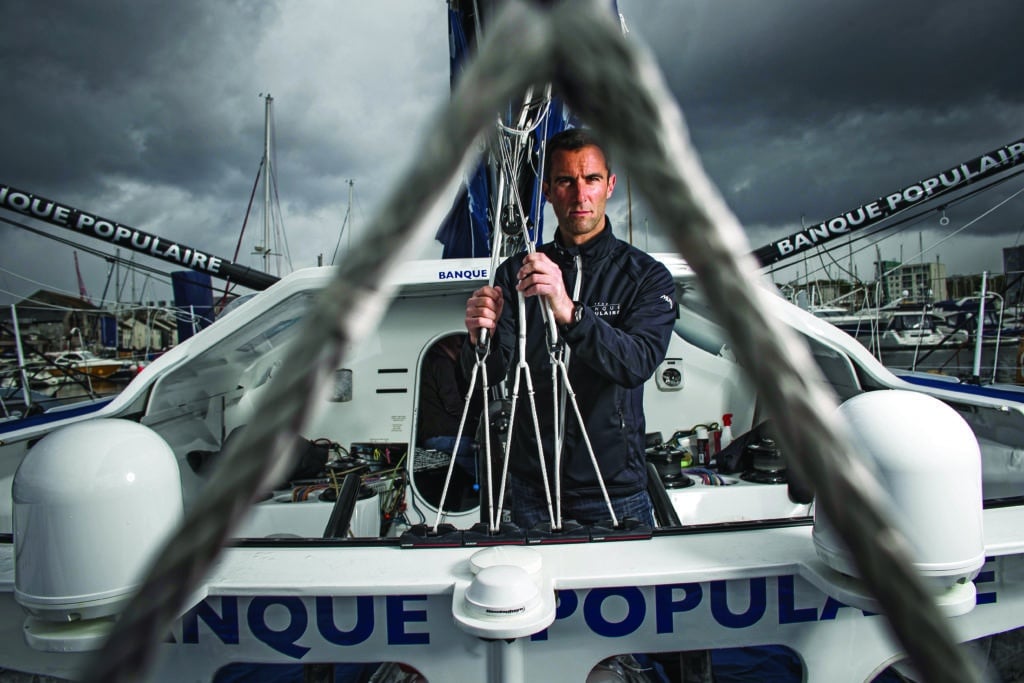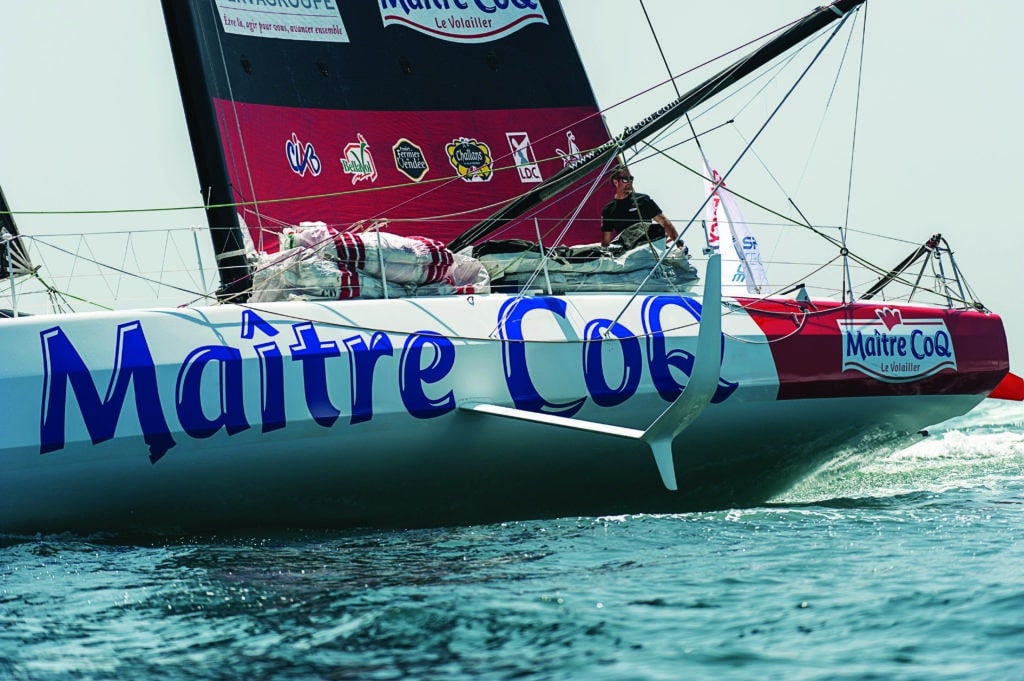
The Transat Bakerly
When François Gabart reached Les Sables-d’Olonne on January 27, 2013, thousands of fans had braved the drizzle for hours to greet him. It was late at night and much colder by the time Armel Le Cléac’h arrived. Three hours after the victor was crowned, the crowd at the dock had thinned out. Adding to 39-year-old Le Cléac’h’s misery was how his second-place finish was in many ways a repeat of the same scenario four years before, behind Michel Desjoyeaux.
Le Cléac’h has had more than three years to think about what he could have done differently. Understandably, it has been of little consolation to know that he lost the race by a hairline margin to Gabart. He has already begun to apply his very Cartesian analysis to how he can go faster this time around with the extra speed of the new Banque Populaire’s IMOCA foil design.
“I have really focused on the Vendée Globe since the new boat was put in the water,” Le Cléac’h says. “We have been sailing with the foils for about a year and have learned a lot, although we are still learning as well.”
Work remains on the foils’ lightweight aluminum composites, which, among other things, must be able to withstand 8 metric tons of force when Banque Populaire leans on either its port or starboard side in big seas and as it reaches speeds approaching 30 knots.
During the 2015 Transat Jacques Vabre, Le Cléac’h’s Banque Populaire was the only boat of four with foils to finish the race. Le Cléac’h and Erwan Tabarly were second, but had been forced to hold back during parts of the race. They opted to add reefs to the mainsail when the wind was gusting over 30 knots, due to concern about the foils.
After the Jacques Vabre, Banque Populaire‘s engineers set out to make the boat sturdier, which was instrumental in Le Cléac’h’s first-place finish in the Transat bakerly to New York this year — with the foils well intact. “The architects said they had underestimated the force and pressure on the foils before the Jacques Vabre, but they then changed the carbon materials and the results were much better,” says Le Cléac’h. During the return from New York to Les Sables-d’Olonne, Le Cléac’h collided with what he describes as a “very large yet unknown fish,” causing one of the foils to break apart and other damage.
“We are making the aluminum composites even more reliable after the collision,” says Le Cléac’h. “Collisions will always remain a risk, but I will have a much better chance than I did before to finish the race, despite a foil breakage after hitting something.”
The importance of having one of the fastest (and possibly most fragile) boat designs in the Vendée Globe fleet is obviously less important than Le Cléac’h’s sailing skills.
“Even if you give him a slower boat, Armel will find creative ways to make it faster,” says Kevin Escoffier, head of engineering for Team Banque Populaire and winner of the Transat Jacques Vabre in 2005, noting how Le Cléac’h managed to fight Desjoyeaux to the finish in the Vendée, despite mainsail difficulties and other technical issues.
Le Cléac’h is a sailor who is never satisfied with the status quo, whether looking to save days by seeking a low-pressure front or a fraction of a knot to gain 10 minutes over a 24-hour period. Without exception, he takes the competitive quest to make the boat go faster to the extreme, never letting go, Escoffier says. Hence the nickname “the Jackal.”
“A jackal will always hunt for his prey and will never let go,” Escoffier says. “It is also the Figaro mentality, because you are always seeking to improve your speed at all times in that race, just as Armel will do in the Vendée Globe.”
Le Cléac’h’s competitive spirit and personality have also been a good fit for shorthanded rather than team sailing outside of the Vendée circuit. After making a name for himself in France’s racing circuit by winning the Solitaire du Figaro in 2003, he was world IMOCA champion in 2008 and won the doublehanded Transat AG2R in 2004 and 2010. He also finished first again in the solo Figaro in 2008, before his second-place finish in the 2008-09 Vendée Globe.
Le Cléac’h plans to sail an additional 20,000 miles before the start in November, as well as sail with his wife, Aurélie, and their two children in Corsica. His immediate goal: total devotion to relaxing in the Mediterranean sun with his family.
“I am now taking a break and will do some easy cruising that will have nothing to do with racing,” he says. “But when I get back, everything will change.”

SAILING – NEW YORK – VENDEE 2016
Battle of the Foils
As of mid-July, 30 boats were registered for the 2016-17 Vendée Globe. With six of those boats outfitted with foils, the race will be a showdown between innovation and tried-and-true methods of circumnavigation.
In theory, the L-shaped foils provide an advantage in certain conditions, such as a 10 percent speed bump in reaching wind conditions of over 15 knots. The foils bear enough force to counter leeway and increased righting moment. Armel Le Cléac’h says the IMOCAs with foils could sail up to 5 percent faster on average over the entire around-the-world course.
The teams will seek fronts that allow the boats to sail at angles of 85 to 125 degrees, in the “sweet spot.” “You can be sure that the navigation software will guide the boats to where they can take advantage of the wind angles that will truly make them fly,” says Kevin Escoffier, head of engineering for Team Banque Populaire.
The Achilles’ heel of the foil pack, however, is reliability, prompting different teams to reinforce the foil composites since last year, including through the use of softer materials. Banque Populaire‘s hull also had to be redesigned, to better absorb shock in case of an impact.
Since last year, there have been improvements. Most recently, Jérémie Beyou on Maitre Coq won the New York-Vendée Transat with foils. “People are starting to warm up to foils after many improvements and are beginning to realize the design is the best choice for the Vendée Globe,” says Le Cléac’h. “A lot has been learned about how they work since they have been introduced.”
Yet IMOCA-class foils are not a magic wand that will guarantee who finishes first in the Vendée, says PRB skipper Vincent Riou.
“In our case, foils would not give us an advantage to win,” says Riou. “In certain conditions, the boats with foils will go faster, but not enough to convince us to make the switch, especially when our data shows we will go faster most of the time with the previous design.”









